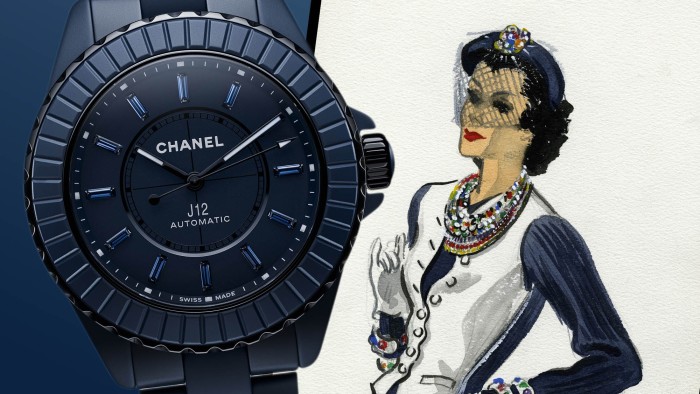Unlock the Editor’s Digest for free
Roula Khalaf, Editor of the FT, selects her favourite stories in this weekly newsletter.
Twenty-five years on from the launch of its innovative J12 watch, Chanel is back championing ceramic. The French house is introducing a third colour to its best-selling model, unveiling the J12 Bleu at the Watches & Wonders fair in Geneva on Tuesday.
Following five years of research and development, a dark blue ceramic features on eight of nine new limited-edition creations. “It’s a blue that over the decades you find in a number of creations at Chanel, namely in fashion in the way that Gabrielle Chanel played with blue and black in her jackets,” says Frédéric Grangié, president of Chanel’s watches and fine jewellery division.
He says the brand’s “most emblematic material” is one that symbolises luxury because of the expertise required to make the ceramic pieces. “It’s important for us to celebrate our manufacturing capabilities with these creations and take the J12 into a new territory, which is that matt finish with [the] satin-touch blue ceramic,” says Grangié. The house, which supplies other watchmakers with ceramic, launched the J12 in black in 2000 and white in 2003.
Chanel is not alone in embracing the material; ceramic is popular with many brands. “What is really interesting is the fact that ceramic is at the same time very light and very hard, so this makes it possible for us to produce watches that will stay almost as new over the years, without scratches,” says Emmanuel Dupas, Tag Heuer technical director. It is also “a nice way to bring colour” to watches, he adds.
Today brings a battle of the blues. In addition to Chanel’s launch, Zenith is releasing three limited-edition chronographs, featuring a specially developed blue ceramic, to mark the brand’s 160th anniversary. And, away from Watches & Wonders, Audemars Piguet is unveiling a new ceramic shade on three models from its Royal Oak and Royal Oak Offshore collections. This deep blue is inspired by the “Bleu Nuit Nuage 50” colour developed for the dial of the first Royal Oak in 1972.
In February, Hublot announced what it described as the world’s first multicolour ceramic watch. The Big Bang Unico Magic Ceramic features a dark grey ceramic bezel with a pattern of blue circles.
Mathias Buttet, director of research and development at Hublot, says its patent-pending process is unique because, rather than being limited to colour layers on the surface, “the blue dots pass all the way through the structure, much like knots in a tree trunk”.
Buttet says Hublot can now combine any colours except black as, due to its chemical make-up, it contaminates other hues. However, he says this is “only a temporary obstacle”. The brand is celebrating the 20th anniversary of its Big Bang collection at Watches & Wonders with five limited-edition designs, including one in red ceramic.
But it is not only colour that brands are exploring. Tag Heuer machined a block of ceramic for the case of its white Monaco Split Seconds Chronograph F1, launching today, rather than using the more common injection moulding technique. Whereas the moulding technology “forces you to add round edges on your piece”, Dupas says machining “makes it possible to have these very sharp lines that are true to the DNA of the Monaco watch”.
The process allows for the same precision as with a metallic case. “Usually when you have ceramic cases, the movement is fitted into a metallic case and the water tightness is done on this metallic case, and then the ceramic . . . has no real technical functions,” says Dupas. “Here . . . the movement is directly fitted into the ceramic case, and the ceramic case is watertight.”
The brand took inspiration from the use of ceramic in F1 cars (for example, in engine components) for the limited edition of 10 pieces, which celebrate its return as official timekeeper in the sport’s 75th anniversary year. It is Tag Heuer’s first model to feature ceramic pushers, a ceramic crown, and ceramic bridges inside the movement.
The use of ceramic in watchmaking is not new. IWC launched the first watch with a high-tech ceramic zirconium oxide case, the Da Vinci Ceramic Perpetual, in 1986. “But it wasn’t until the year 2000 that ceramic became really cool and that was because of Chanel with the J12,” says Paul Boutros, deputy chair and head of watches for the Americas at auction house Phillips.
Watchmakers, increasingly, are embracing the material. Last year, Piaget used ceramic for the first time, in the Polo Skeleton collection; Bremont created its first full-ceramic case; and IWC unveiled its Ceralume technology for fully luminous ceramic cases.
Boutros says collectors value ceramic watches because they are more limited in production, due to the difficulties in manufacturing, and harder to obtain from brands that sell them to their “best customers”. Sought-after models at auction include early examples by IWC and rare Chanel J12s, with pieces by Richard Mille and Audemars Piguet having risen in value compared with their retail price, he adds. Phillips sold a limited-edition white ceramic Richard Mille (2021) for $330,200 in December.
Boutros thinks “ceramic is here to stay”. “As watches are becoming more mainstream and collectors [are] wanting something different, the fact that you can create different case and bracelet colours using ceramic gives brands the ability to have a diverse offering to attract even more clients,” he says.
Read the full article here

